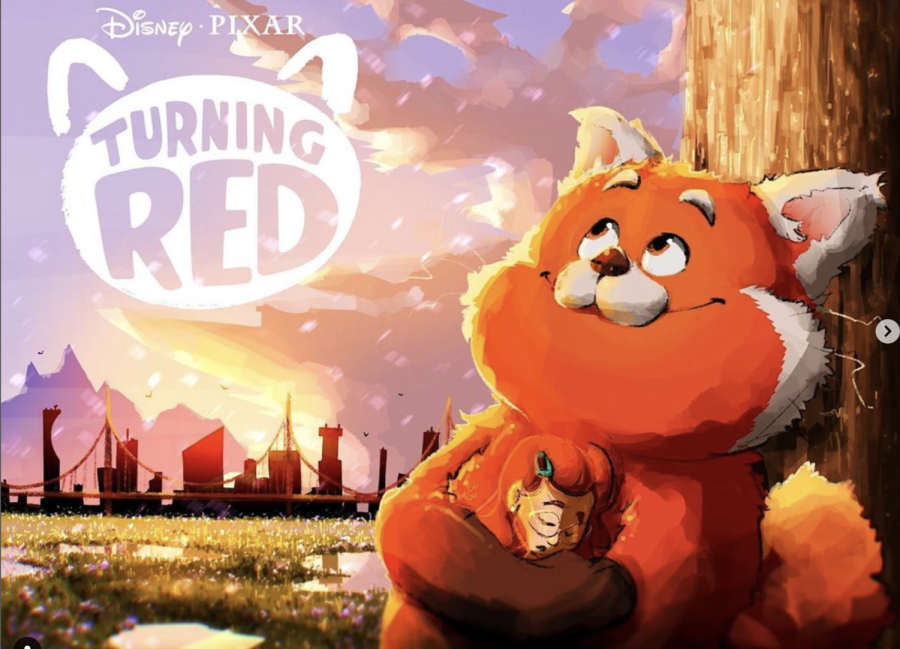Conner’s Critiques: “Turning Red” and “Embracing the Panda” are fever-dream insights on the struggles of growing up.
April 20, 2022
“Turning Red,” released on Feb. 21, 2022, tells the story of Mei Lee as she faces the trials of growing up while having a strained relationship with her mother.
First and foremost, this movie is a brain-breaking abstraction of a Pixar movie. It’s an absurd reality in which every single thing you thought wouldn’t happen happens, and gives your brain a break from the stresses of reality in the most bizarre way possible. It crams what feels like an encyclopedia of information, lore and backstory into an hour and forty minutes. However, despite the initial panda-monium, it’s a fantastic movie.
The detailing on the animation is wonderful. Looking closely at the red panda that Mei Lee turns into, the textured strands of hair that cover her look very realistic. The background scenes are also very detailed, the shadows that the picture frames create, the grain on the wooden cabinets and the inconsistent coloring of the grout on the tiled floor. In older, animated Pixar movies, these things look plasticky.
The movie includes a lot of prominent characters seen in East-Asian media. For example, the even larger red panda that Mei’s mother turns into near the end of the movie is very similar to the city-wrecking, Japanese figure, Godzilla. And the boy band, 4*town, is similar to the popular music genre K-pop, adoring fans and all.
Many of the songs in the soundtrack that have actual words in them are almost laughable. They all have vocals from the band, 4*town, who play a very prominent role in the movie, and the lyrics are almost cringe-level cheesy. However, when “Nobody Like U,” is combined with the ritualistic Cantonese chanting heard and seen later in the movie, the song becomes a remix that is apprehensively enjoyable.
Excluding the whole “turning into a giant fuzzy” dilemma that our main protagonist faces, the struggles that Mei confronts are very relatable to viewers of all genders and ethnicities. For example, the struggles depicted show family conflict and concerns about the future.
It would have been nicer if the writers fleshed out Mei’s friends more. At the beginning of the movie, Mei is walking into school and greeting all of her friends, all of whom have very distinct personalities and preferences. After that, however, not much is known about them. After seeing their vibrant personalities in the beginning, this is a big let down.
Another plot point that Pixar could have improved is not changing its main character into an animal. Although the whole premise of this movie is about a teenage girl who turns into a red panda, this movie would just be another coming of age story without that factor. And Pixar shows that it still has no concept of creativity or new ideas when it comes to characters of color in fictional movies.
In both old and new animation, Pixar erases the defining characteristics that make the main character a person of color. For example, in the movie “Soul,” Pixar changes Joe from a black man to a blue blob: in “Spies in Disguise” they turn Lance from a black man into a pigeon: “Coco” sees the main character Miguel turned into a skeleton: “Brother Bear” erases Kenai and replaces him with a bear: in “Princess and the Frog,” Pixar turns both Tiana and Naveen into frogs and in “The Emperor’s New Groove,” Emperor Kuzco is turned into a llama.
All of these characters have prejudices attached to their racial identity, and when Pixar erases those features it feels like a cop-out, taking away a crucial part of what makes the person of color a person of color. Not only that, but turning the characters into an animal or something non-human erases representation for them in an already whitewashed-media-filled world.
After the movie, watching the documentary, “Embracing the Panda,” gives viewers a more in-depth explanation of the thought process behind the animation and the plot. The main crew and production team of this movie are all Asian-American women. This factor makes the characters feel more realistic, as the people behind the film actually know what they are talking about in terms of growing up female, as opposed to if a male director or producer had made the movie with no experience on what it’s like to grow up as an AFAB person.
It’s really cool to see the inspiration for a lot of the scenes in the movie. For example, Mei’s family lives adjacent to a temple and so, for inspiration, Domee Shi, the director, went and visited many Chinese temples around California. The red panda element is also discussed in the documentary: how the whole idea of becoming a red panda is a metaphor for puberty and how you’re suddenly big and smelly and hairy, all of which are big issues that come with puberty.
Overall the film on its own is a mish-mash of chaos and provides a refreshing break from the struggles of reality. It could have done a few things better, but it is still a good movie. The insight provided in the accompanying documentary adds another layer of depth to the characters that allows you to further relate to the characters.












